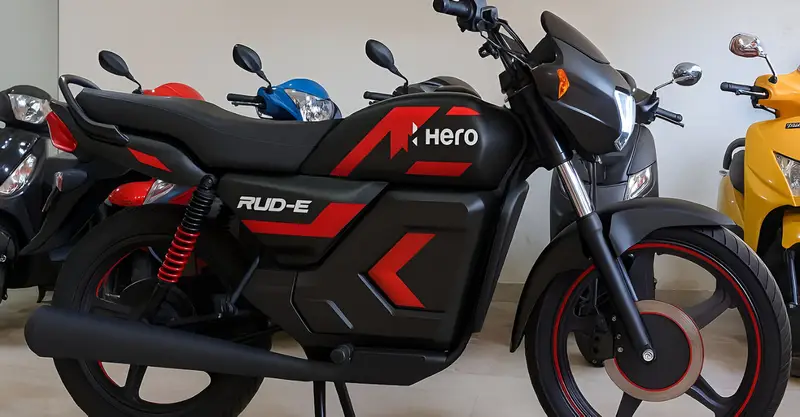The Hero Splendor Electric 2025, expected to launch in India around late 2025 or early 2026, brings the iconic Splendor name into the electric vehicle era. Priced between Rs. 99,000 and Rs. 1.10 lakh (ex-showroom), it targets daily commuters, students, and eco-conscious riders, competing with electric two-wheelers like the Bajaj Chetak Electric and TVS iQube. With its blend of classic design, practical range, and modern features, it aims to redefine affordable electric mobility.
Classic Yet Modern Design
The Hero Splendor Electric 2025 retains the familiar Splendor silhouette with a round headlamp, long seat, and minimalist body, now updated with a matte finish in colors like Matte Black, Blue Accent, and Silver. The traditional fuel tank space transforms into a storage compartment, while LED lighting and subtle blue accents add a contemporary touch. Weighing around 110 kg with a 785 mm seat height, it offers easy handling for a wide range of riders, though the glass-like finish may need a case for grip.

Practical and Vibrant Display
Featuring a semi-digital instrument cluster, it displays speed, battery level, and trip data with clear visibility even in daylight. The 6-7 inch display supports basic connectivity options, making it user-friendly for daily use. While not as advanced as some premium electric bikes, its simplicity ensures reliability for commuters navigating urban and rural roads.
Efficient Electric Performance
Powered by a 3 kW (around 4 bhp) BLDC motor with a high-capacity lithium-ion battery, it delivers a top speed of around 75 km/h and 0-40 km/h in about 7 seconds. The battery offers a range of 120-180 km per charge (with an optional extra battery pack), ideal for city commutes and short highway trips. Charging takes 4-5 hours on a standard socket or 1.5 hours for 80% with fast charging, balancing practicality with convenience.
Reliable Camera and Safety Features
While primarily a commuter bike without a traditional camera, it includes safety features like a combined braking system (CBS) with drum brakes front and rear, ensuring stable stops. The low center of gravity and tuned suspension with telescopic forks and twin rear shocks handle India’s bumpy roads well, though it lacks advanced safety like ABS in base models.
Long-Lasting Battery and Charging
The removable lithium-ion battery, with a capacity supporting 120-180 km, provides 1-2 days of typical use (around 50-70 km daily). Supported by fast charging, it reaches full capacity in 4-5 hours or 80% in 1.5 hours, outperforming many rivals in range and recharge time. It’s designed for home charging, with compatibility for public EV stations, though no wireless option is available.
Connectivity and Practicality
Supporting basic connectivity with a USB port for charging devices, it includes a side-stand cut-off for safety. Sensors like speed and battery indicators enhance usability, while the lightweight build aids maneuverability in traffic. It lacks advanced features like Bluetooth but focuses on essential commuter needs.
Pricing and Availability
Priced at Rs. 99,000 (base variant) to Rs. 1.10 lakh (top variant with extra battery) (ex-showroom), on-road prices in Delhi range from Rs. 1.10 lakh-1.30 lakh, including RTO (around Rs. 8,000-10,000) and insurance (around Rs. 3,000-4,000). Available at Hero MotoCorp dealerships and online platforms, bookings may require a token amount. Offers include subsidies, EMI plans, and exchange bonuses. Maintenance costs are low at around Rs. 1,000-2,000/year, supported by Hero’s extensive network. Delivery wait times are estimated at 15-30 days, with high demand for Blue Accent. The warranty covers 1 year for the device and 6 months for the battery, extendable to 2 years.
User Feedback and Drawbacks
Anticipated feedback highlights the impressive range, low running costs (around 25-30 paise/km), and familiar design. The eco-friendly appeal and Hero’s reliability are praised. Drawbacks include:
- No ABS in base models, unlike some competitors.
- Limited connectivity features.
- Higher initial cost compared to petrol variants.
- Potential range anxiety in rural areas with sparse charging.
Comparison with Competitors
This electric bike competes with:
- Bajaj Chetak Electric (Rs. 1.00 lakh, 100 km range, 60 km/h): Shorter range, similar price.
- TVS iQube (Rs. 1.05 lakh, 150 km range, 78 km/h): Better connectivity, slightly higher cost.
- Ather 450X (Rs. 1.40 lakh, 150 km range, 90 km/h): Premium features, higher price.
It excels in range and brand trust but may lag in advanced tech and safety features.
Speculative Notes
The launch date varies between late 2025 and early 2026, with price estimates aligning around Rs. 99,000-1.10 lakh. The 120-180 km range is consistent, though some claims of 200 km seem optimistic. Buyers should confirm details with Hero’s official channels.
Final Thoughts
The Hero Splendor Electric 2025, expected in late 2025 or early 2026, offers a classic design, 120-180 km range, and 3 kW motor with 75 km/h top speed at Rs. 99,000-1.10 lakh. Ideal for daily commuters seeking eco-friendly options, it blends reliability with modern tech, though it lacks some advanced features. Backed by Hero’s network, it’s a strong choice for India’s electric future.